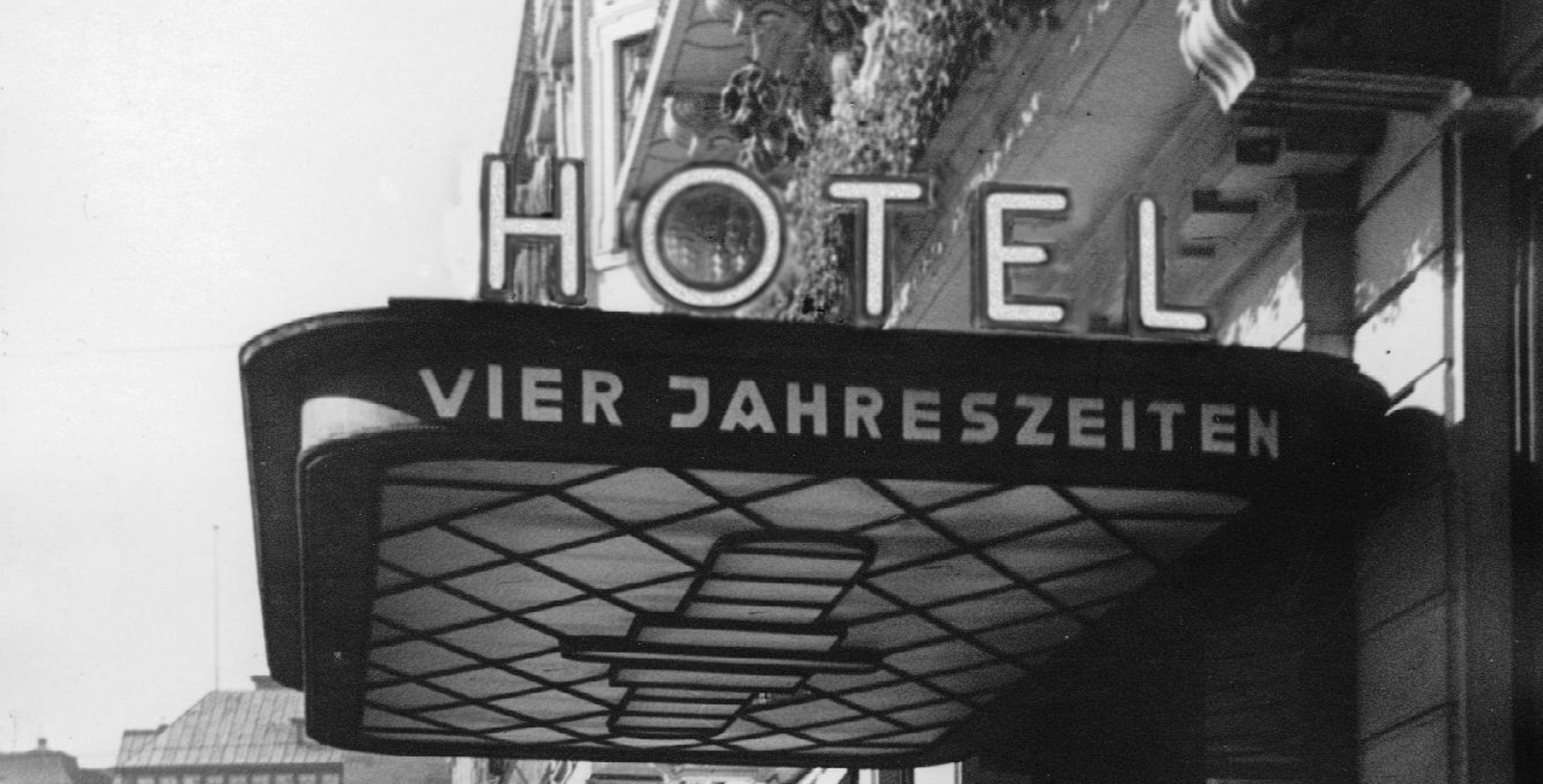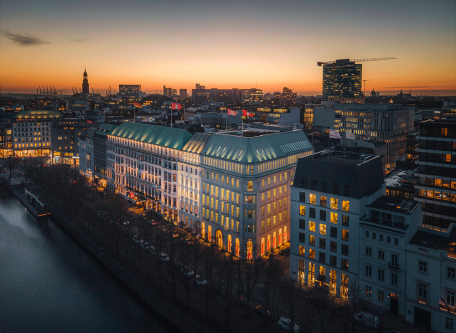Receive for Free - Discover & Explore eNewsletter monthly with advance notice of special offers, packages, and insider savings from 10% - 30% off Best Available Rates at selected hotels.
history
Discover Fairmont Hotel Vier Jahreszeiten, which has been a cherished local landmark in downtown Hamburg for more than a century.
Fairmont Hotel Vier Jahreszeiten, a member of Historic Hotels Worldwide, dates back to 1897.
VIEW TIMELINELocated on the shoreline of the majestic Binnenalster (Inner Alster Lake), Fairmont Hotel Vier Jahreszeiten has been one of Germany’s finest places to visit for more than a century. This impressive historic hotel has specifically been the destination of choice among visitors traveling to the area, whether they be prominent politicians or sightseeing tourists. Fairmont Hotel Vier Jahreszeiten also possesses a storied past that dates back to the very height of Europe’s Belle Époque period. In the 1890s, a veteran hotelier named Friedrich Haerlin first founded the Fairmont Hotel Vier Jahreszeiten in downtown Hamburg alongside his wife, Thekla Toussaint. Incredibly ambitious, the two had cultivated a considerable career in the European hospitality industry by the time they opened the hotel. Friedrich had spent much of his youth training at flagship locations across the continent, including stints at the Grand Hotel Thunerhof and the Grand Hotel d’Orien. Marrying Thekla in 1891, the couple subsequently began managing the luxurious Hotel Bellevue in the Swiss canton of Bern. Nevertheless, disagreements with the main owner prompted Friedrich and Thekla to leave Switzerland. In 1897, they eventually bought a quaint residence in Hamburg to function as the nucleus for their own hotel. Consisting of a mere 11 guestrooms, the “Hotel zu den Vier Jahreszeiten” was small yet charming. The purchase was a substantial investment for the couple as well, costing them more than 420,000 marks. Both Friedrich and Thekla threw themselves into operating the nascent business, working diligently to nurture the growth of their beloved hotel. They spared no expense, ensuring that it appropriately met the demands of their clientele, starting with a massive expansion that accrued another 100,000 marks in total expenses.
More extensive construction projects commenced not long thereafter, which enlarged the building and increased its guestroom count tenfold. By the beginning of the 20th century, the prosperous hotel had come to offer modern plumbing, central heating, electrical fixtures, and even a telephone network. Perhaps the most stunning venue to debut was a marvelous reception hall that quickly emerged as the main event venue for Hamburg’s social elite. In fact, the hotel had come to host some of the most influential people in Europe, including the brother of Kaiser Wilhelm II of Germany, Heinrich of Prussia, and his spouse, Princess Irene of Hessen-Darmstadt. (Among the most frequent guests to stay at the hotel, the German royals gradually became close friends with Friedrich and Thekla!) However, tragedy struck when two of the family’s four children, Otto and Wilhelm, died fighting in World War I. Furthermore, mutinous sailors had seized the hotel briefly amid the tumultuous German Revolution of 1918, mistreating it significantly. But all was not lost for the Haerlins. The youngest son, Fritz, had managed to survive and returned to Hamburg after the war. Having undergone his own hospitality apprenticeship, Fritz assisted his parents while they resurrected the hotel. Indeed, the entire Haerlin family treated the era as an opportunity to further complement the building’s distinctive services. Among the best venues they debuted were the renowned Haerlin Restaurant and the Art Deco-inspired Jahreszeiten Grill in 1919 and 1926, respectively. The Haerlin family had commissioned the creation of many new architectural elements, too, like a gorgeous fifth-floor balcony and a breathtakingly beautiful copper-green roof.
Then, in 1932, Friedrich Haerlin decided to retire and gave the business to Fritz. Despite the change in management, Fritz Haerlin nonetheless succeeded in maintaining the hotel’s prestige. He continued to add terrific amenities on-site, ultimately opening a popular confectionary known as “Condi.” The hotel flourished as such, although it was forced to shut down temporarily when the British Army requisitioned it for use as a military headquarters after World War II. Illustrious figures from across Europe also continued to visit the hotel in great numbers, including Thomas Mann, Peter Ustinov, Maria Callas, and Aristotle Onassis. (Romantic partners at the time, Callas and Onassis vacationed at the hotel together on several occasions throughout the mid-20th century.) But Fritz Haerlin eventually passed away in 1975, leaving the Hotel Vier Jahreszeiten to his widow, Agnes, and their daughters. The Haerlin family then continued to watch over the hotel for many more years before finally selling the enterprise to Japanese real estate developer Hiroyoshi Aoki during the late 1980s. Now known as the “Fairmont Hotel Vier Jahreszeiten” today, this hallowed historic landmark is currently under the ownership of Kurt Dohle and his family. Dedicated to upholding the rich reputation of the hotel, they have striven to safeguard its fascinating institutional history and architectural integrity. The Dohle family has been assisted in their work by general manager Ingo C. Peters as well, who first began his career as a bellboy at the Fairmont Hotel Vier Jahreszeiten. (Peters himself has masterfully fulfilled the role of general manager since 1997.) Thanks to their staunch commitment, the future of the Fairmont Hotel Vier Jahreszeiten has never looked brighter.
-
About the Location +
Nestled along the banks of the historic Elbe River, Hamburg is an incredible metropolis with a rich cultural identity. Not only is the city the second largest in all of Germany, but it is also the linchpin to the country’s entire modern economy. Central to its economic status is the bustling port that sits at its center, which is among the busiest throughout Europe. In fact, the area routinely harbors thousands of commercial vessels annually and has the single largest container terminal in the world! (Those vessels specifically come from the North Sea by way of the Elbe.) Despite its cultural significance today, its origins are actually far more humble. Indeed, the first known record of settlement dates back to the Dark Ages, when an ancient Germanic king called Louis the Pious ordered the construction of a castle on the site in the early 9th century. Referred to as “Hammaburg,” the castle essentially guarded the Elbe against Viking raiders. The safety the keep provided gradually attracted villagers to the location, too, who formed a town of the same name. Its strategic importance to the region even inspired the Catholic Church to install a bishopric within the nascent community, making it an independent political jurisdiction during the subsequent medieval era. But while the citadel was eventually abandoned not long thereafter, the accompanying town nonetheless managed to survive under the name “Hamburg.” Much of the town’s endurance was derived from its proximity to the North Sea, which offered traveling merchants the ability to easily transport their wares to places elsewhere on the continent.
Hamburg grew steadily as such, leading to its steady expansion into the size of a real city. Another legendary German king, Frederick Barbarossa, had even granted Hamburg the status of a “Free Imperial City” during the late 12th century, affording it distinctive tax rights capable of bolstering its flourishing commerce. Perhaps the greatest symbol of Hamburg’s economic preeminence was its role as the nerve center for the Hanseatic League. A powerful commercial confederation of several coastal market towns, the Hanseatic League dominated maritime trade in both Northern and Central Europe for generations. Hamburg itself functioned as the point through which most of the League’s trade flowed, creating tremendous wealth for its inhabitants. Gorgeous buildings soon dotted the city’s skyline in turn, which reflected the distinctive architectural trends then dominating the coast of Northern Europe at the time. (Some scholars posit that the structural motifs mirrored ones found in the present-day Netherlands rather than Germany.) Among the most glorious buildings to debut were towering cathedrals like Hauptkirchen St. Petri, Hauptkirchen Sankt Jacobi, and Hauptkirchen Sankt Nikolai-Kirche. The city’s prosperity continued for many years as well, enduring epidemics, disasters, and wars. Hamburg’s lucrative trade network even managed to outlive the Hanseatic League, which dissolved into irrelevancy during the 16th century. In consequence, Hamburg became a prolific center for the arts by the beginning of the European Enlightenment, coming to host now-famous intellectuals like Johannes Brahms, Heinrich Heine, and Johann Wolfgang von Goethe.
Hamburg’s centuries-long era of financial success ended abruptly when the armies of French Emperor Napoleon Bonaparte annexed the city amid the eponymously named “Napoleonic Wars.” Although restored back to the status of a “free city” in the wake of the conflict, Hamburg experienced another calamity when a great fire devastated its neighborhoods in 1842. Undeterred, its citizens managed to rebuild Hamburg back to be stronger than ever, introducing grand shipyards and factories across the cityscape. Then, in the mid-19th century, Hamburg was a founding member of several successors of modern Germany: the German Confederation, the North German Confederation, and the German Empire. Hamburg proceeded to further emerge as an important economic site in Europe, buoyed by the growing number of exports arriving from other regions within the newly founded German state. The community had thus risen to become one of Europe’s leading cities at the dawn of the 20th century, entertaining countless companies, wharves, and warehouses. But while the city suffered immediate hardship following both World Wars, it still managed to endure as a major port and commercial hub for many years thereafter. Contemporary Hamburg is now known for its cosmopolitan diversity, hosting numerous cultural institutions and popular festivals. In fact, the city is hailed for its extensive variety of museums, such as the Hamburger Kunsthalle, the Altonaer Museum, and the International Maritime Museum. However, the community is also a popular tourist destination in the present, attracting cultural heritage travelers due to its historic landmarks like the Hamburg Rathaus, the Deichstraße district, and the UNESCO-recognized Speicherstadt.
-
About the Architecture +
While the Fairmont Hotel Vier Jahreszeiten displays an eclectic blend of architectural styles, perhaps one of the most notable is Art Nouveau. Part of the greater cultural phenomenon known as the “Belle Époque,” Art Nouveau architecture was among the most popular styles in Europe from the 1890s till the outbreak of World War I. It quickly appeared across the continent, referred to by such names as “Glasgow Style,” “Modern Style,” and “Sezessionsstil.” Some of Europe’s most prominent architectural minds employed Art Nouveau architecture, too. Perhaps the greatest example was Hector Guimard, who used the style to create his wonderful Castel Béranger. The term itself was derived from an article published in the L’Art Moderne to introduce the work of architectural collective Les Vingt toward the end of the 19th century. Nevertheless, architects who embraced Art Nouveau were among a growing demographic of intellectuals who yearned to create novel artistic forms that broke with the imitative historicism of the past. More importantly, they wanted their new architectural motifs to reflect imaginative creativity, especially as European society became increasingly more structured and industrialized. Over time, those professionals created a design aesthetic characterized by its curvaceous lines and use of organic shapes. Objects from nature were featured prominently throughout the façade of every structure, including the likes of insects and exotic plants. Surfaces often contained terra cotta coverings and ornate tile moldings spread throughout the interior. Sloped arches also defined the windows and doors, while fantastic mosaics existed on nearly every ceiling. Asymmetrical layouts structured many Art Nouveau buildings as well, providing a unique appearance in many of Europe’s sprawling cities.
However, areas of the Fairmont Hotel Vier Jahreszeiten also showcase elements of Art Deco architecture. Art Deco architecture itself is among the most famous architectural styles in the world today. The form originally emerged from a desire among architects to break with past precedents to find architectural inspiration from historical examples. Professionals within the field instead aspired to forge their own design principles, hoping that their ideas would better reflect the technological advances of the modern age. Historians thus consider Art Deco to be a part of the much wider proliferation of cultural “Modernism” that first appeared at the dawn of the 20th century. Art Deco as a style first became popular in 1922, when Finnish architect Eliel Saarinen submitted the first blueprints to feature the form at a contest to redevelop the headquarters of the Chicago Tribune. While his concepts did not win over the judges, they were widely publicized, nonetheless. Architects in both North America and Europe soon raced to copy his format, giving birth to modern Art Deco architecture. The international embrace of Art Deco had risen so quickly that it was the central theme of the renowned Exposition des Art Decoratifs in Paris a few years later. Architects the world over fell in love with Art Deco’s sleek, linear appearance defined by a series of sharp setbacks. They also adored its geometric decorations that featured motifs like chevrons and zigzags. But in spite of the deep admiration people felt toward Art Deco, interest in the style gradually dissipated throughout the mid-20th century. However, many examples of Art Deco architecture still survive in the present, with some of the best located in major European cities like London, Paris, and Berlin.
-
Famous Historic Guests +
Eugen d’Albert, pianist and composer best remembered for his opera Tiefland
Heinz Rühmann, actor known for his roles in movies like The Captain from Köpenick and It Happened in Broad Daylight
Carl Zuckmayer, writer and playwright known for works like Der blaue Engel, The Captain of Köpenick, and Des Teufels General
Helmut Kautner, director known for films like Der Hauptmann von Köpenick, Under the Bridges, and Große Freiheit Nr. 7
Maria Callas, opera singer noted for her famous use of the bel canto singing technique
Albert Ballin, shipping magnate who ran the Hamburg-Amerikanische Packetfahrt-Actien-Gesellschaft, which was once the world’s largest shipping company
Aristotle Onassis, business tycoon who once owned the largest privately owned shipping fleet in the world
Thomas Mann, novelist, writer, and social critic who won the Nobel Prize in Literature in 1929
Peter Ustinov, actor best remembered for his roles in such films as Spartacus, Death on the Nile, and Qua Vadis
Princess Irene of Hesse and by Rhine (1866 – 1953)
Prince Heinrich “Henry” of Prussia (1862 – 1929)


























